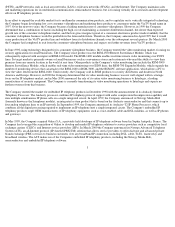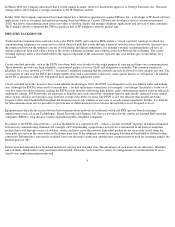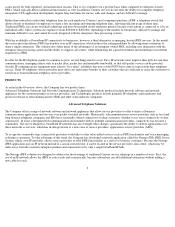8x8 2000 Annual Report Download - page 15
Download and view the complete annual report
Please find page 15 of the 2000 8x8 annual report below. You can navigate through the pages in the report by either clicking on the pages listed below, or by using the keyword search tool below to find specific information within the annual report.analog telephones and fax machines to the IP network. To provide a high degree of scalability and reliability, Netergy Networks uses a modular
and distributed architecture for the iPBX system. In this architecture, a single instance of the iPBX server software provides complete PBX
functionality, but it is designed to support approximately 100 extensions. Limiting the number of extensions supported limits both the
processing capacity and memory requirements of the server platform, allowing less powerful, less expensive servers to be used. Multiple iPBX
instances can be run on each server, and the system can be scaled by adding more servers.
This modular approach has another advantage. By limiting the capacity and therefore the size and processing requirements of the iPBX
software, an instance of the iPBX can be dedicated to a specific customer. Doing so allows each instance to be customized for each customer
by linking it to customer-specific computer programs for call center automation or by selecting unique functions for feature phone buttons.
Much of the flexibility of the iPBX is due to the use of abstraction layers between the core iPBX engine and the devices with which it
interfaces and which it controls. To allow it to interface to a variety of different telephone sets, PSTN gateways and softswitches, the iPBX
uses hardware drivers that support various industry standard and proprietary call setup and teardown protocols. Currently, the iPBX supports
session initiation protocol (SIP), media gateway control protocol (MGCP), H.323v2 and a variety of proprietary protocols.
To allow easy integration with computer programs (computer telephony integration, or CTI), the iPBX was based on the ECTF C.001
specification for PBX functionality and supports Sun Microsystems' Java Telephony Application Program Interface (JTAPI 1.3). The ECTF
C.001 specification defines a consistent call control behavior for PBXs, making it easier to develop computer programs that can control a PBX,
and the JTAPI provides an industry standard series of function calls to allow computer programs to control PBXs from more than one
manufacturer. Computer programs interfaced to the PBX might provide a graphical user interface to make call transfers or conference calls
easy, or they might connect a company's customer relationship management software directly to the phone system, displaying customer
information on a computer screen when that customer calls for support.
The Netergy iPBX was written entirely in the Java programming language. Java provides a number of important advantages over older
computer languages such as C and C++. For example, all Java programs run in a Java Virtual Machine, which translates Java code to a specific
operating environment, such as Windows or Sun Solaris. The Virtual Machine also provides memory management, eliminating pointer
arithmetic and supplying automatic garbage collection, frequent sources of problems in other development environments. Java removes coding
ambiguities (direct access to memory, machine dependent integer format, unsigned numbers, etc.), as well, another common problem with C
and C++.
Running each instance of the iPBX in its own Java Virtual Machine (VM) offers a number of advantages. First, every instance of the iPBX is
completely insulated from every other instance, so a failure in one should never cause a failure in any other. In other operating environments,
system resources such as communications routines, database managers and so on are frequently shared between all of the programs that run on
that machine. If one program misuses a display driver, for example, all of the other programs running on that machine may be affected.
Because each Java VM provides all of these resources to the program it hosts, this kind of inter-process interference does not occur.
A second advantage is security. Because each iPBX instance is separate from all others, its configuration data is separate also. Thus, it is much
less likely that another user will inadvertently (or purposely) misconfigure another customer's iPBX.
System Design
The Company has developed expertise in integrating its semiconductors and software with peripheral components to produce complete IP
telephony and multimedia communication systems. The Company's system technology consists of modular subsystems that can be combined
and rearranged to interface to various networks (such as POTS, ISDN, Ethernet LAN and home networks) and to interface to various telephony
devices, such as the analog phones in a home. The Company's system design expertise includes design and
12
























